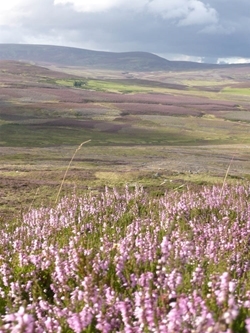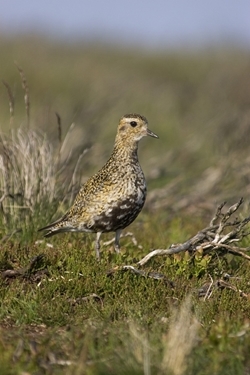Key points
- This study revisits sites ten years after previous surveys showed significant increases in ground-nesting birds in response to predation management.
- Across the board, huge declines in threatened birds such as golden plover, curlew and grey partridge were observed.
- Meanwhile, with no lethal control in place, generalist predator populations such as red fox and carrion crow have soared.
- These results show predation is a key limiting factor on the recovery of ground-nesting bird populations.
Background
 There are growing concerns about the rising populations of generalist predators and their likely impact on ground-nesting birds. The UK now has the highest density of crows (carrion and hooded crows combined) in Europe, and the third highest population of red foxes. These increases are likely driven by a combination of factors including an abundance of food linked to human activity, loss of apex predators and an increase in non-native commercial woodland plantations, which offer both shelter and nesting opportunities for predators.
There are growing concerns about the rising populations of generalist predators and their likely impact on ground-nesting birds. The UK now has the highest density of crows (carrion and hooded crows combined) in Europe, and the third highest population of red foxes. These increases are likely driven by a combination of factors including an abundance of food linked to human activity, loss of apex predators and an increase in non-native commercial woodland plantations, which offer both shelter and nesting opportunities for predators.
This ecological imbalance has serious consequences for vulnerable bird species. Many studies have stated that predation can limit ground-nesting waders. Two studies have shown that lethal control of predators results in improved breeding success and population size of ground-nesting farmland birds such as grey partridge.
One of these studies, known as the Upland Predation Experiment, took place from 2000 to 2008 across four upland plots in Northumberland, each ranging between 9.3 and 14.4 km² (approximately 930–1,440 hectares). Two of these plots were located on the Ministry of Defence’s Otterburn Training Area. Over the course of the experiment two gamekeepers successfully reduced red fox abundance by 43% and carrion crows by 78%. The associated breeding success of lapwing, golden plover, curlew, red grouse and meadow pipit improved by around 300%.
This new paper reports on surveys undertaken across this same area, in 2018 and 2019, ten years after predation management, including lethal control, ceased.
What they did
The original experiment involved four large areas of similar countryside including moorland and rough grassland, grazed by sheep and cattle. Each area was 9-14 square kilometres in size and was spaced 6-7km apart.
Two of the areas were on Ministry of Defence land and two were on former grouse moors. The researchers used a controlled design: some areas had gamekeepers actively reducing predator numbers like foxes and crows, while others had no predators controlled. In one pair of plots, lethal control was switched halfway through the study to compare effects directly. The other pair kept the same treatment throughout.
Researchers regularly counted a range of birds, including wading birds like curlew and lapwing, gamebirds like red and black grouse, and predators such as buzzards and foxes. Surveyors used GPS to record bird locations during the breeding season and checked for fox activity by counting scats along fixed routes.
They also monitored changes in the plants and vegetation by recording species and height using small sampling plots spread across each site. The habitat management stayed the same throughout the study to separate out the effects of predator control.
In 2018 and 2019, researchers returned to repeat the surveys and see what had changed in the years since the original experiment ended. They then used statistical models to compare the results from the original study period with those from 2018/2019, focusing on bird numbers, fox activity and vegetation.
What they found
Ten years on from the original experiment, all four wader species had reduced in population when resurveyed: golden plover by 81%, snipe 76%, and curlew 24%, with a non-significant decline of 58% for lapwing. Of the three main gamebirds, red grouse was the only species to not have gone locally extinct, although numbers dropped by 74%. Grey partridge had become locally extinct in the two plots where they were originally present, while black grouse declined from 69 displaying males in 2003 across the whole area to zero from 2014 onwards.
Carrion crows and fox scats had significantly increased across all plots by an average of 78% and 127% respectively. Sightings of protected avian predators (buzzard and raven) showed non-significant increases of 48% and 110% respectively across both plots.
The amount of heather and purple moor grass did not change between the original study years (2002-2008) and 2019. The heather height stayed about the same, averaging just over 30cm. Other types of vegetation, like rushes and grasses were about 35% taller in 2019 compared to earlier years. This could be explained by potentially better weather or a longer growing season in 2019.
What does this mean?
 The results of the paper show that predation is a key limiting factor on the recovery of ground-nesting bird populations.
The results of the paper show that predation is a key limiting factor on the recovery of ground-nesting bird populations.
The decline in ground-nesting bird species recorded by this study mirrors national trends since 1995, with lapwing and curlew now red-listed, and snipe and red grouse amber-listed. These declines reflect widespread reductions in predator and habitat management across UK uplands, often following the loss of grouse moor management to forestry or other land uses.
Although the habitat did not change at Otterburn, numbers of predators like goshawks, foxes and crows increased a lot from the time of the initial study to the resurvey in 2019. Goshawks are known to kill a large proportion of grouse in countries like Sweden and Finland. Their numbers in nearby Kielder Forest rose significantly, which may be linked to the grouse decline, though this has not been proven. Other predators such as red foxes and carrion crows also bounced back quickly once predation management stopped.
Addressing predation of vulnerable birds is not straightforward, but this latest study highlights the urgency for action if certain populations are to be safeguarded and recovered. Removing predators like foxes and crows has had positive effects on ground-nesting bird populations in other studies. For example, the Langholm study in 2019 showed when predator control resumed at Langholm Moor in Scotland, curlew, golden plover and snipe numbers increased.
As well as predator control, other measures which could improve the breeding success of threatened ground-nesting birds include such as non-native forests. Saving these birds will need a package of measures tailored to different landscapes and local circumstances, but in many cases lethal predator control will provide the short-term boost to breeding success that is required while longer-term and larger-scale solutions are devised.
Read more: New research shows rise in predators is threatening red-listed birds with extinction
Read the original abstract